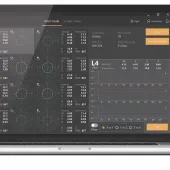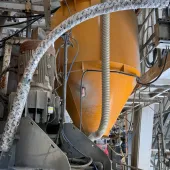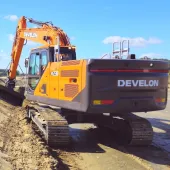Reducing Waste in the Haul Cycle

First published in the November 2020 issue of Quarry Management
Chris van der Loo, business area director for Trimble’s Weighing and Aggregates business, including Loadrite products, looks at how improved technology is delivering benefits through analytical insights and data-driven decision-making
Optimizing efficiency is an ongoing challenge for any aggregates operator. Identifying, eliminating and controlling waste in the haul cycle is key to staying on schedule and improving the bottom line, but inefficiencies can be difficult to identify and overcome. However, the difference between efficient and inefficient operations can be significant.
A study from EY and the Sustainable Minerals Institute, for example, reports that companies that successfully use data outperform their peers by 20% and continue to generate additional value through analytic insights that allow informed data-driven decision-making at an executive level. Benefits can be realized in time savings, worker and equipment productivity, and increased profitability. Real- or near-real-time insight into operations, including how efficiently equipment moves material from the beginning to the end of the process, allows ongoing incremental changes that boost production and profits.
Eliminating waste in the workflow
Eliminating waste has long been an area of focus for fleet managers, but a number of obstacles and limitations have prevented detailed insight into where waste is generated and how to address it. Traditional truck scales may not provide accurate payload measurement until the machine is moving, which is too late to optimize the load. Production data is typically siloed, with no feedback to other operators and equipment, or the wider team responsible for the site, region or division via a central data hub.
‘Many solutions manage productivity by section, checking if a key performance indicator (KPI) is good or bad. Managers can then focus on the ones that are off,’ said Steve Franklin, chief executive officer of Cement & Aggregate Consulting. ‘But the granular data is also important to allow us to break down each component of every haul cycle. A good dashboard allows managers to manage by exception, and also look deeper into the haul cycle when required to compare against site targets. When we load trucks to payload accurately, I expect a 20–30% increase in productivity, as a rough guess. We see very under-utilized load-haul fleets, which leads to lost revenue, higher capital costs and lower profitability. Most sites can do more with their existing equipment, personnel, and resources.’
To date, haul-cycle monitoring has required managers to evaluate stale data or make decisions with incomplete or incorrect data. It can take days – or weeks – before operational data is available for review. Managers can only then make changes to improve operations based on what happened some time ago, but periodic modifications can be imprecise. In other cases, a problem might be obvious – perhaps the cycle time or load or haul times are too long; but the root cause and how to fix it may be elusive.
‘There are big opportunities for improvements in most load and haul operations,’ said Mr Franklin. ‘Trucks and loading tools are generally not sufficiently utilized, and there are three steps to address that:
- Get the equipment working.
- Increase the rate, in terms of volume, or tonnes/h moved.
- Improve loading accuracy.
‘Making well-informed decisions using accurate data is key to all three steps.’
Load and haul as part of the connected fleet
The landscape is changing as technology improves – including more precise, durable, automated networked sensors for weighing loads; improved location precision and geofencing to monitor load-haul trucks; faster, more reliable on-site communications; and real-time cloud-based reporting that integrates mobile equipment; and productivity information presented as easy-to-read reports with critical key KPIs.
‘It can be challenging to get timely, accurate load-haul data without being on site,’ said Mr Franklin. ‘Downloading data from trucks manually is expensive, and the information is always out of date. We should be able to access detailed information remotely.’
Solutions that give visibility across the operation, such as Trimble’s new Smart Haul system, have ushered in the age of the connected fleet. Integrating accurate excavator onboard scales, truck location tracking, and Insight dashboards provide a holistic view and the ability to make adjustments during the shift. Operators and managers can access automated, accurate information to help production and operations make better-informed business decisions.
By automating data capture as much as possible, and by reducing operator interaction with the system, the data match for payload data combined with truck data is eliminated. There is no reliance on a human pressing a button at the correct moment, and that independence from the operator helps eliminate errors that taint data sets, improving accuracy. This improves the learning curve for new operators, and keeps experienced operators focused on using their equipment efficiently. The result of automated collection is a significant improvement in capturing a reliable, useful data set to drive operational improvements.
The result is the ability to make proactive changes to eliminate waste. Rather than implementing operational decisions based on last week’s data, site managers can use a current status to proactively make decisions and modify operations. This means that instead of addressing issues from days ago that are likely to no longer be relevant, managers can make changes hourly, or even minute by minute.
On one job site, for example, there was a bottleneck at the dump point. While the unloading process itself was going smoothly and as predicted, trucks were being delayed because the traffic light to let trucks unload was slow to respond. Using a system that measured the time of each phase of the cycle allowed the fleet manager to quickly identify the delay and implement a quicker signal change that reflected the true unload time, fixed the problem and reduced the overall cycle time. Shortening the light cycle yielded a site-wide productivity improvement of 10%.
Where to look for improvement
There are two main areas where managers can focus to improve operations and decrease waste and inefficiency in their hauling system:
- Operational efficiency – How well are trucks being loaded? Is every load at capacity? Are they being loaded with the right material? Are loads going to the right destination? How long does it take to complete a load cycle? Something as simple as slow spotting time can create a significant site-wide slowdown if it is not monitored. Are the truck manufacturer’s guidelines on loading and overloading being adhered to?
- Utilization – How well are on-site assets being managed? Are machines idle? Are trucks waiting to be loaded or to unload? Is traffic flow across the operation smooth and efficient? Are the right operators working on the right equipment? Are excavators waiting for trucks to arrive for loading? Are operators loading and hauling efficiently? Is refuelling being handled efficiently? A holistic view of load and haul can indicate a need to add another truck or excavator to the workflow or to identify slower operators who may need more training or a re-training refresher session.
By taking a close look at the answers to these questions, operators can gain a lot more visibility into the overall business and can often find opportunities to eliminate waste and improve efficiency – and profitability.
‘We worked with a site and reviewed their haul truck payload reports, which showed, month after month, they hauled an average 52 tonnes per truck load,’ recalled Mr Franklin. ‘When reviewing the data, it showed the correct payload was 61 tonnes. The actual payload must be compared with the percentage of target payload. In this case, their truck fleet was 20% larger than needed because they failed to load that last nine tonnes to every truck. Those two extra trucks were about $3 million in capital, plus operating costs and maintenance – that’s about $1 million a year in extra operating costs.’
Connecting the dots
The benefits of a connected load-and-haul system, near-real-time central data gathering across the fleet, and fast, efficient reporting are significant. Site management can identify problems, including bottlenecks, that hurt production efficiency. They can provide individual feedback to operators to improve their performance without more intrusive intervention. Tracking progress in real time, including material movement from dig to dump, allows hour-to-hour and day-to-day gains, as well as overall operational improvements. Better asset management, from improved utilization of the fleet to better loading and optimized haul cycles, means fewer delays, increased efficiency and a stronger bottom line.
Operators should look for a system that helps them ensure each load is optimized, and that supports mixed fleets. This will provide one view to access the whole fleet and improve data integrity by automating tasks and taking the data burden off operators so they can focus on their jobs. It is also important to select a system that gathers load data from the excavator for accurate loading, and if it is important for end-users to use existing reporting tools, look for one that provides raw data through an application programming interface (API). And, importantly, select a system with a user-friendly interface that allows quick and simple use of the data and customizable setup, so each user sees the most useful information.
Improved technology – across hardware, data aggregation and analysis, and networks – makes data more important every day for those tracking and improving every operational phase. An integrated approach to monitoring and assessing load-haul operations is critical to improving asset management, adjusting on the fly to address problems and boost efficiency, keeping projects on time, and improving the bottom line.
- Halomec are the authorised UK distributor for Trimble
- Subscribe to Quarry Management, the monthly journal for the mineral products industry, to read articles before they appear on Agg-Net.com








